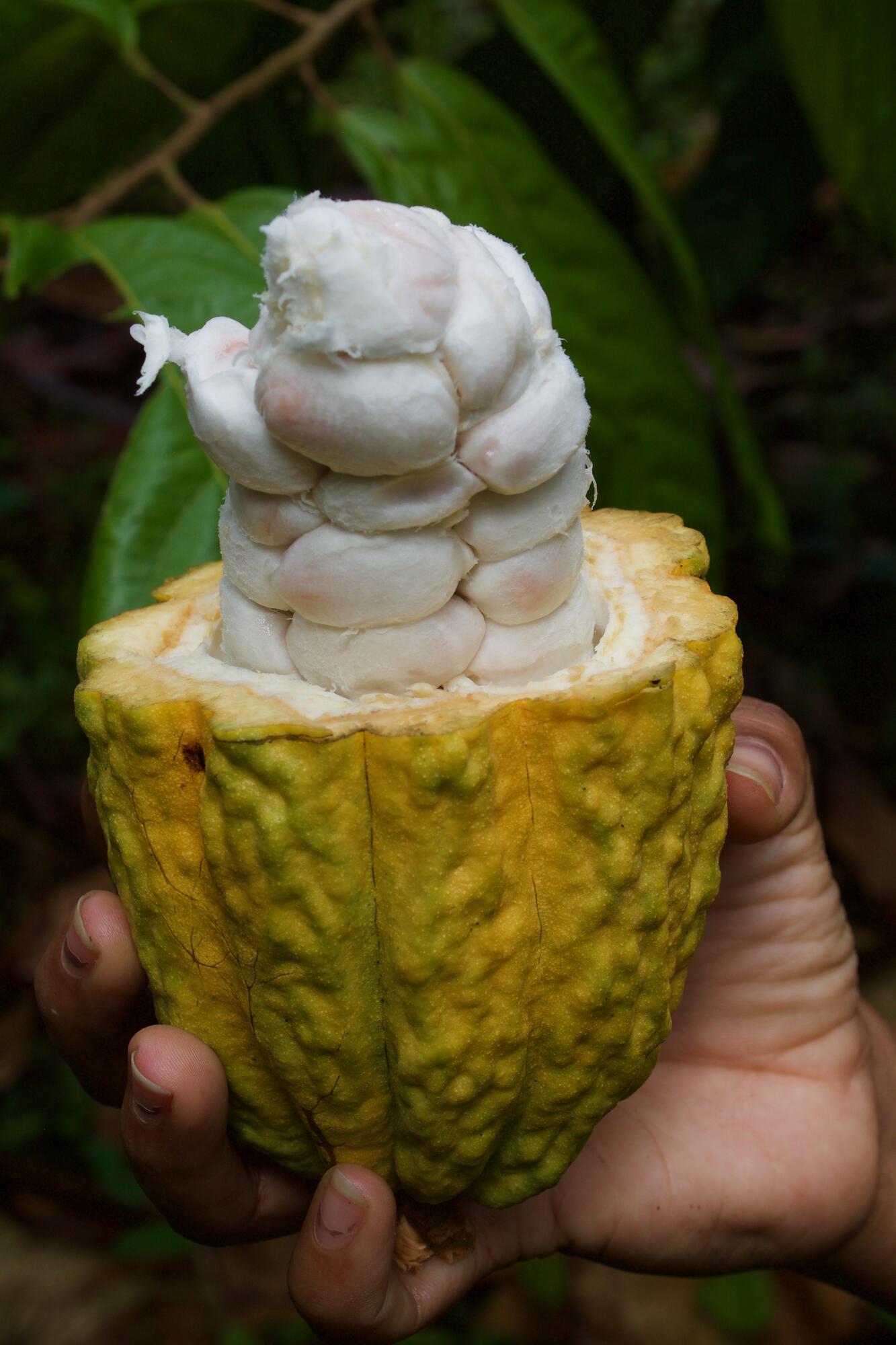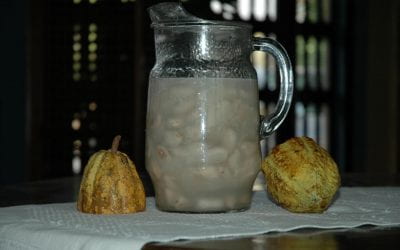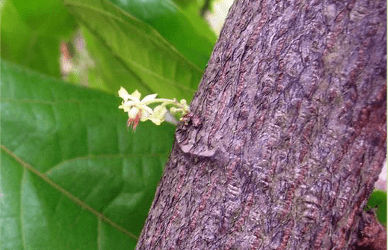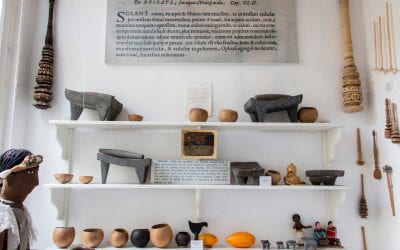Cocoa versus Cacao
Commodifying the “Authenticity” of Latin American Chocolate

In Cobán, Guatemala in September 2017. Workers at Cacao Verapaz loading bags of fermented and dried cocoa into a shipping container for exportation to the US.
One early morning in September 2017, I bought a bean tamale for two quetzals, equivalent to a U.S. quarter. The middle-aged vendor wore a multi-colored cloth skirt, snug above the waist and falling to mid-calf, and a knit mesh crop-top over a purple tank. Her skirt and blouse style characterized the attire of the K’iche peoples (Mayan descendants) in the highlands of Guatemala.
I stood next to a McDonalds in Cobán—a city in the center of Guatemala that tourists only pass through on their way to a famous emerald river several hours to the east—waiting for two men that I had never met. I had been in Guatemala for a month working with a cocoa exporter during a semester off from college and that day, I was shadowing a field visit with a local poverty-alleviation non-profit.
Over the following year and a half, I would visit cocoa farms across Belize, Colombia, Indonesia and Ghana, and speak with chocolate companies, cocoa traders, governmental extension officers and cocoa research institutions in a dozen other countries. I would get a job at a chocolate factory in Massachusetts only to quit two weeks later (Willy Wonka had unsurprisingly romanticized that experience). I would write a 130-page senior thesis, for my special concentration on Food and the Environment at Harvard, that focused on private-sector cocoa sustainability initiatives but barely scratched the surface of everything I had learned about the world of chocolate.

Charcoal drawing I made in May 2018 of a cacao pod.

Charcoal drawing I made in May 2018 of a cacao bean cross-sections
This article reflects on a mere sliver of these experiences and on how even the simple distinction between cocoa versus cacao indicates the craft chocolate industry’s eagerness to associate with chocolate’s Latin American heritage (For consistency, I refer to cocoa with its prevailing name as a global commodity. I use cacao when referring to the tree’s scientific name and when directly quoting sources that use that terminology.). Through challenging the idyllic portrayal of cocoa’s heritage, I hope to complicate the narrative of Latin America’s indigenous development more generally.
***
The field technicians, one heavy-set and the other small but brawny, picked me up in Cobán and we began our two-hour dirt-road journey to a cocoa association. Sitting in the back seat and looking out over rolling hills of fog-draped coffee plantations, I ate my bean tamale, still warm with condensation clinging to the plastic bag that held it.
We arrived at the cocoa association by mid-morning and the sun had already begun to scald everything in sight. A woman wearing the same K’iche style of cloth skirt and mesh top as the tamale vendor was hand-grinding cocoa beans and corn into a mortar. She then mixed the paste with water from a pot above a crackling fire and handed each of us the warm beverage in a Styrofoam cup. I thanked her, but we were not able to communicate further as my K’iche dwindled after “hello” and “thank you” and many elders in rural Guatemala do not speak Spanish. This bitter drink, with a light froth on top from the cocoa fat, was how Mayans first consumed cocoa before the Spanish invaded and later mixed the novel bean with sugar. The Mayans considered the drink sacred. Carvings on the sides of Mayan pottery depict women stone grinding and frothing cocoa, and the scene had just manifested before my eyes like a history textbook re-enactment.

Charcoal drawing I made in May 2018 of a farmer holding a cacao pod in Sierra Nevada, Colombia.
The two technicians led a workshop for the local farmers on the importance of a business mindset when managing their cocoa farms. At lunch—corn tortillas with a side of beans—the hosts offered a choice between knockoff Coca-Cola or more cocoa beverage. Ecstatic to be consuming chocolate in its “most original” form, I chose cocoa without hesitation. All the local farmers, mostly men, chose the sweet soda.
***
My chocolate journey began in Latin America, as did the biological journey of Theobroma cacao—the tree whose fruit has seeds that are ground into chocolate.
Theobroma cacao evolved in the Amazon River Basin somewhere near modern-day Peru, Colombia and/or Venezuela—each country claiming the divine tree’s heritage. The word cocoa is anglicized from Spanish cacao, which in turn stems from Nahuatl cacahuatl, the language of the Aztec Empire. Despite the words cocoa and cacao referencing the same food, the craft chocolate industry often employs cacao to signify higher quality; it interprets cacao, the Spanish word, as being closer to the food’s biological and cultural origin in Latin America. Using the term cacao to signify higher quality politicizes the term by inherently associating Latin American origins, as opposed to African or Asian origins, with higher quality cocoa.
Starting during the end of the 1600s through colonial conquest, the Spanish brought cocoa to Southeast Asia, and the Portuguese later brought it to West Africa. Today, West African nations account for around 70% of the world’s cocoa production, with The Ivory Coast alone producing 40% of the global market, followed by Ghana, Indonesia and Ecuador.

My hand holding a cacao pod on a farm near Punta Gorda, Belize in October 2017.
As Theobroma cacao only thrives within 20 degrees north and 20 degrees south of the equator, the Global South produces all of the world’s cocoa (a few small tourist-centered plantations in Hawaii and Northern Australia being the only exceptions). However, just a handful of food corporations in the Global North processes a majority of this cocoa into chocolate. Farmers only realize three to six percent, depending on the estimate, of the profits from retail chocolate bars.
As with most tropical commodities, there is no straightforward remedy to cocoa’s supply chain inequities. My biggest takeaway from my two years of research on the topic: those who claim to have the stand alone solution are often the furthest from it. Small craft chocolate companies have proliferated in the last decade and have boasted the premiums they pay farmers for fine-flavor cocoa, but I dedicated an entire chapter of my senior thesis to discussing the myriad limitations of this trade model.
One of these limitations is the cost of operating on a small scale and the resulting price of the product; two-ounce bars from craft chocolate makers commonly exceed $10. To sell these more expensive bars, companies conflate the chocolate with compelling stories of its production. Thus, consumers do not just buy a product; they buy into ideals that in turn validate their consumption. This marketing, however, can promote exotic notions of indigenous farmers.
***

Inside the storage warehouse for Maya Mountain Cacao in Punta Gorda, Belize, in October 2017.
Several months after returning from Guatemala, I secured funding for a 10-day research trip to Colombia over spring break. I was there during the peak of mango season on the northern coast and I ate about 12 of them a day.
In the suburbs of Santa Marta, Colombia, in the Arhuaco tribe’s urban headquarters, I interviewed a tribal leader. He had just come back from a trade show in Europe with a chocolate company that purchases cocoa from his community. He joked that chocolate companies only invite him to these events because he wears his traditional regalia, which looks good for the company. We discussed the economics of Colombia’s chocolate industry and then be-friended each other on Facebook.
Halfway through our conversation, the elder stepped outside to chew coca leaves with several other male leaders. They passed around a dried gourd filled with lime from powdered seashells—the compound that activates the psychoactive effects of coca—bantered in their native tongue and used sticks to smoosh the coca wads that swelled their cheeks. I sat silently, admiring the multi-millennium-old ritual.
***

Inside the storage warehouse for Maya Mountain Cacao in Punta Gorda, Belize, in October 2017.

Cacao pod on a farm near Punta Gorda, Belize in October 2017.
The Arhuaco tribe suffered tremendous displacement through the Spanish colonial conquest and later during the Colombian civil war. The United States fumigating their territory with toxic herbicide (Monsanto’s glyphosate) during anti-drug campaigns did not help. This enduring culture deserves deep respect, but chocolate companies that use Arhuacan cocoa often leverage the perceived exoticness of the indigenous producers to an extent that disregards the tribe’s development. Following are a few examples of descriptions on craft chocolate bars from Origional Beans, Castronovo Chocolate, and Endorfin. I have bolded keywords that promote an exotic fantasy of chocolate production.
“Heights of sweet spice, licorice and sesame rise gently in this select tribal Businchari cacao made according to ancient Arhuaco tribal traditions that are designed to maintain the world’s natural harmony. Your purchase of the harmonious Arhuaco 82% helps strengthen this guardian culture and the pristine landscapes it protects.”
“A place where all of the Earth’s biomes are found from the Caribbean Sea to the rainforest to grassland to the glacial peaks of the Sierra Nevada de Santa Marta. A place where global change is closely monitored and kept in balance by its caretakers, the Arhuacos. They are descendants of the Tairona, an ancient civilization dating back to the 1st century AD. The Tairona grew cacao and prepared it as a drink. The Arhuacos today live a traditional village lifestyle led by their spiritual leaders, the Mamos.”
“Not only are you moments away from enjoying the rarest cacao beans in their purest form—you are breaking ground for a tree”
“The wild heirloom cacao is harvested by the Arhuaco indigenous people and brought down the steep slopes on the backs of mules in jute sacks. The locals measure the journey not by distance but by how long it takes to smoke their “tobacco,” a homemade cigar.”
“Single Origin Arhuaco Ritual Drinking Chocolate, 100% Ceremonial Grade”
The bolded words from the above texts—tribal, ancient, maintain, natural harmony, harmonious, guardian, pristine, balance, caretakers, descendants, ancient civilization, traditional village lifestyle, spiritual leaders, rarest, purest, wild heirloom, indigenous, backs of mules, jute sacks, homemade, ritual and ceremonial—reinforce primitive stereotypes of indigenous cultures. Furthmore, each of the cited marketing texts uses the term cacao rather than cocoa, demonstrating the eagerness of craft producers to affiliate their chocolate with cocoa’s cultrual and biological roots.

A cocoa farmer holding a cacao pod in Sierra Nevada, Colombia in March 2018
Chocolate companies might economically empower the Arhuaco tribe through purchasing its cocoa beans, but I argue that marketing a typified representation of indigenous identity to prompt consumption is both reductive and exploitive. The presence of familiar digital technology—as well as air conditioning, Facebook and international travel—in the Arhuaco community does not undermine the community’s natural traditions. Rather, it refutes the reductive and ‘othering’ depictions from chocolate companies of the tribe as an undiscovered culture within a virgin landscape. Glorification of indigenous producing communities is not limited to the Arhuaco tribe and persists throughout depictions of Latin American cocoa origins.
All West African cocoa producing communities are indigenous, with cultures as distinctive as that of the Arhuaco tribe. Chocolate companies, however, do not market the exoticness of producers in this region in the way they do in the above texts for the Arhuaco tribe. This is due to the assumption that indigenous communities in South America are culturally and geographically closer to Theobroma cacao’s origin. They are “authentic.”
***
Many craft chocolate companies describe their products as “bean-to-bar” to underscore the close relationships they build between farmers and consumers. After witnessing the rapid commercial growth of the bean-to-bar industry, large chocolate companies have co-opted the word bean-to-bar in their marketing. Meiji, a Japanese food manufacturer and world’s fourth largest confectionery company, launched a self-identified bean-to-bar series, called THE Chocolate, in the fall of 2016. Thirty million bars sold in the first year, making it one of the most successful Japanese food launches in decades.

Cacao pods on a farm in Sierra Nevada, Colombia in March 2018.
Meiji, like most large chocolate companies, sources most of its cocoa from West Africa, but its subsidiary, THE Chocolate, has “single-origin” bars from exclusively Latin America: Venezuela, Brazil and the Dominican Republic. The THE Chocolate website proudly explains that the specialty bar developers specifically sought out beans from Venezuela because it was “cacao’s country of origin,” and “the source of all good chocolate.” However, at the very bottom of the webpage about its single-origin bars, an asterisk in small print notes, “*We mainly use cacao beans from each specified region.” With this caveat, each of THE Chocolate bars could very well include beans from West Africa, but the website never mentions West Africa.
The website for THE Chocolate exclusively uses the term cacao, while the general Meiji website uses cocoa. The terms cacao and bean-to-bar spotlight the proximity of THE Chocolate’s cocoa to chocolate’s origins, consiquently leveraging the narrative of cocoa’s origin to sell bars of acclaimed high-quality. It fetishizes the authenticity of Latin American cocoa.
***

Fermenting cacao beans near Zambrano, Colombia in March 2018.
Despite the reality of Latin America’s globalization, tourists and consumers increasingly seek out pristine preservations of a romanticized past. Millennials travel in elusive pursuits of untouched nature and culture. They buy craft chocolate that portrays the distant cocoa-producing communities in Latin American as Edenic. Cocoa—grown by indigenous groups in tropic rainforests—becomes a refuge for connecting to the past. In a 2009 research paper on Fair Trade and ethical consumption, Varul Matthias, a German sociologist, summarized, “Third World producers who, rural and ethnic, represent a lost authenticity unavailable to the First World consumer. The search for authenticity can tap into the aestheticization of pristine nature and traditional rural life—or into an idealized and distorted image of the producers as moral icons, as noble yet naïve savages.”
When the Mayan-attired woman in Cobán sold me a tamale—a Mesoamerican corn dish that originated more than five thousand years before Christ—the McDonalds backdrop and plastic bag service exemplified the blurry line between modernity and tradition. These markers of global capitalism represented the reality of Latin America’s rapid modernization confronting time-honored heritage. Communities in the highlands of Guatemala have been grinding cocoa beverages for thousands of years, but they now serve them in Styrofoam cups alongside knockoff Coca-Cola. Rather than docile responses to modernity, Latin America’s culture shifts are vibrant collages of resilience and adaptation.
Overemphasizing cocoa’s exotic heritage can underappreciate the modernization and agency of indigenous farming communities. Authentic chocolate celebrates the complex realities of traditional production within the modern global capitalist system.

Fermenting cacao beans near Zambrano, Colombia in March 2018.
Fall 2020, Volume XX, Number 1
Molly Leavens graduated from Harvard College magna cum laude in March 2020 with a special concentration in Food and the Environment, a Studio Art secondary and a Spanish language citation. After graduation, she has a year-long traveling fellowship to learn about the cattle industry in Argentina.
Related Articles
A Food for the Goddesses
Maya women were the artisans who invented a panoply of ancient beverages and sauces containing cacao. This association between cacao and women extended to an association with certain Maya goddesses. While originally introduced from South American, the…
Discovering the Taste of Molecules in Chocolate
English + Español
I’m a chemist. And you generally don’t think about chemistry when you have a delicious cup of chocolate. But I have studied the chemical composition of chocolate for 20 years and I would like to share what I have learned with you. For more than three decades…
Keeping the Heritage through a Museum
English + Español
As an architect, I’ve been fascinated by museums and how the design of spaces can influence the experience of the visitor and the meaning of the objects within. Museums are not only repositories of valuable pieces preserved for posterity, but cultural elements…




